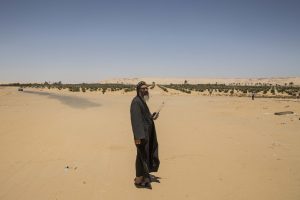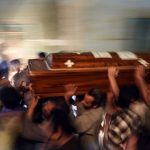By Karoline Kamel – Mada Masr –
Militants killed 28 people traveling to the St. Samuel Monastery in Minya on Friday, a site that has given life and protection to everyone, from Christians and local workers to security forces.
On the main road to Minya there is a sign that reads: “The St. Samuel Monastery.” It marks the start of a rough road where cars, and even SUVs, need to drive with care. Sand storms erupt, obscuring vision, as vehicles navigate what has come to be known as the St. Samuel Monastery Road.
It takes an hour to reach the monastery from the start of the path, and after a few kilometers communication networks cut off. Those traveling along the road are isolated.
It is here that armed militants killed 28 people en route to the monastery as part of a Friday morning excursion. By Saturday, the blood splatters from the attack were already encircled by white bricks, placed by security forces. Solitary shoes and sandals are still scattered along the road, traces of the victims who lost their footwear as they ran for their lives.
A torched SUV can also be seen in the heart of the desert. According to eyewitnesses it belongs to the assailants, who they claim torched the vehicle and fled when it got stuck in the sand.
Those who were not killed during the attack had to walk one kilometer in order to obtain phone signal and call for help.
“Whoever did this knows the geography of the area well, and chose the roughest part of the road. They also know where communications are cut off. It is as if they studied the area well,” says Father Boulos al-Samuely, one of the priests responsible for the monastery’s security.
Father Boulos sits next to Father Angelos al-Samuely, who also oversees security. They wait by the gate to receive journalists and visitors. Following Friday’s attack security forces sent a single armored vehicle accompanied by two police cars which they parked at the start of the the St. Samuel Monastery Road. There is no sign of a security presence on the road, the site of the attack or the monastery itself.
Father Boulos carries two walkie-talkies used for communication within the monastery. The first is used to communicate with Bishop Basilius, head of the monastery, and the other is for internal communication with the rest of the monastery’s fathers and staff.
Security forces seek refuge
“Don’t worry,” Father Boulos tells Father Angelos, quietly laughing. “Tell the story, father.”
Father Angelos and submits and tells the story.
“In the aftermath of the dispersal of the Rabea al-Adaweya sit-in, security forces did not come here, nor did we ask them to come. But on the night of the dispersal, we saw three Central Security Forces vans heading toward the monastery. We went out to see what was happening. We were met by an officer, and we told him that we were safe, and did not need security. He responded: ‘No Father, we are not coming to secure the monastery. The road to Beni Mazar has been cut by demonstrators and we are anti-riot forces, only carrying sticks but no weapons. We are unable to proceed on the road, and we don’t have enough fuel anyway. When we contacted the operations room they told us there was a monastery in the desert, and to go there.’ Their commander called us and asked us to let them spend the night and give them fuel. We ordered the kitchen to prepare food for them in abundance.”
Father Angelos gazes at the floor and stops here. Father Boulos continues: “Father Angelos was in charge on that day. He was worried the monastery may have been infiltrated by someone who may report the security forces, or their location, which could prompt an attack on the monastery. So he spent the night by the gate of the monastery watching the security cameras until they woke up and left in the morning.”
“On Easter, they didn’t even consider sending a vehicle to make sure we were alright,” he adds. On Palm Sunday, one week before Easter, militants carried out targeted attacks on two churches, one in Tanta and one in Alexandria, killing over 50 people.

A spring of life
“I never imagined that this would happen to us, that I would see this day. Why do they do this to people, some of them children, going on an excursion?” asks Father Boulos. He was one of the first of the monks to arrive at the site of the attack.
The St. Samuel Monastery is also known as the Monastery of the Virgin Mary at Mount Qalamoun. The monastery’s manuscripts show that there were a number of hermitages in the region during the second half of the third century AD. The monastery was founded in the fourth century and was rebuilt by the monks at the request of Patriarch Kyrillos Amudeldin in 444 AD. It was attacked by the Berbers between 450 and 635 AD, who took St. Samuel himself captive for three years. The monastery was subsequently raided by the Arabs between 859 and 880 AD, as illustrated in the monastery’s manuscripts. The monastery alternated between reconstruction and abandonment, settling into full-time use in the present day.
Today, the monastery receives Copts visiting from Upper Egypt. People from the surrounding villages, monastery and funeral parlor workers, also have their livelihoods based here. Even though several workers were killed in Friday’s attacks, many returned to work at the monastery the following day.
Daily transport vehicles, covered with cloth ferry workers to and from nearby Minya villages, whether under the blazing summer sun of the summer or the biting cold in winter.
“The monastery employs dozens of Christian families in various sectors. They are poor families who have no other choice,” says father Beyman, who is in charge of the agriculture terrains in the monastery. “Imagine the lives of those who have agreed to work under these harsh conditions: there is no paved road, no communication networks and they are disconnected from their families for hours. It is a life that we as monks have chosen and are satisfied with. But those people are forced into it given their life conditions.”
Like many Christian monasteries in the Upper Egypt desert, the St. Samuel Monastery is self-sufficient. It depends on private generators for electricity, which are turned off at 10 pm everyday and return at 3 am, when the monks start their day with prayer. It is also reliant on its own cultivation, using well water that is desalinated in the monastery. The workers grow and process olives and dates, and bake bread in the monastery’s bakery.
St. Samuel’s hires more workers in the summer, during school holidays and during harvest season when the monastery provides work for young people.
Here, in this wellspring of life, “We would chose Christ, if we were made to choose between him and death. ” Father Boulos says, pensively. “But the right to life is a gift from God. It is only He who can decide to reclaim it, not just anybody. That is why people must know that Christianity loves life.”
Following Friday’s attack, the monks called their families to reassure them they were safe. “I am a monk, which means I am not captured by life and its pleasures. However my feelings for my family do not die, because a monk without feelings is dead,” Father Boulos concludes. “This is why we all called to reassure our families we are alright. We did this, even though we are monks. Can you imagine how those whose children went on this trip, and died and who will not return again must feel? Christians must know that Christianity orders us to be always ready to go to heaven. But this readiness does not mean we don’t want life.”
All photos courtesy of Roger Anis
Translated by Aida Seif al-Dawla





